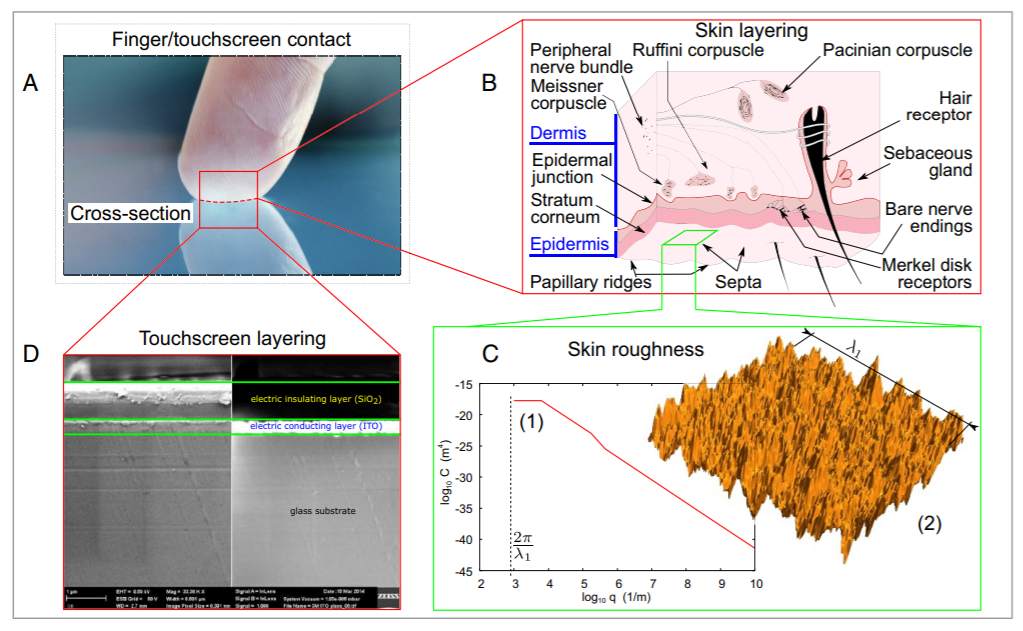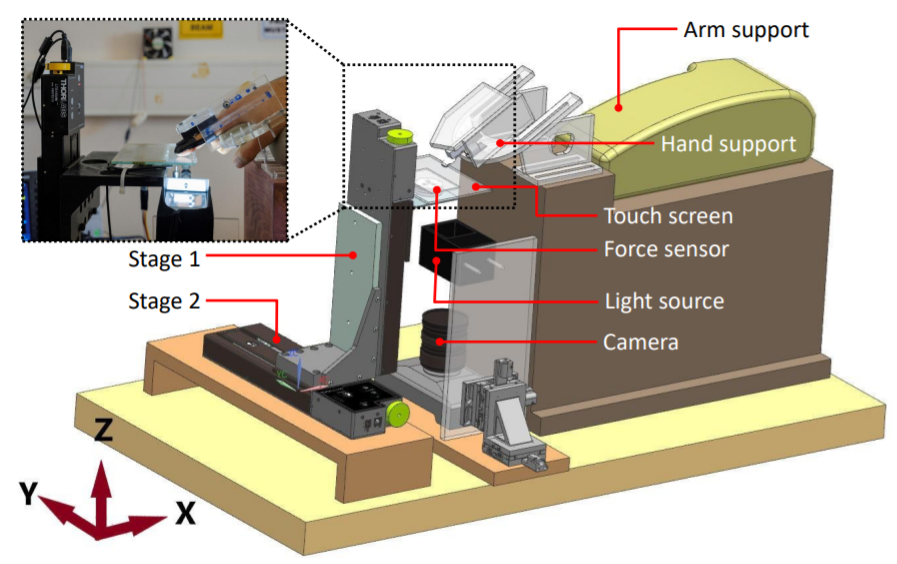Contact Mechanics Between the Human Finger and a Touchscreen Under Electroadhesion
The nature of the contact interactions between the fingertip and the touchscreen under electroadhesion and the effects of confined material properties, such as layering and inelastic deformation of the stratum corneum, on the friction force are not completely understood yet. Here, we use a mean field theory based on multiscale contact mechanics to investigate the effect of electroadhesion on sliding friction and the dependency of the finger–touchscreen interaction on the applied voltage and other physical parameters. We present experimental results on how the friction between a finger and a touchscreen depends on the electrostatic attraction between them.
Step-Change in Friction under Electrovibration
We investigated the tactile perception and the contact mechanics for a step change in friction under electrovibration during a relative sliding between a finger and the surface of a capacitive touchscreen. First, we conduct magnitude estimation experiments to investigate the role of normal force and sliding velocity on the perceived tactile intensity for a step increase and decrease in friction, called rising friction (RF) and falling friction (FF). To investigate the contact mechanics involved in RF and FF, we then measure the frictional force, the apparent contact area, and the strains acting on the fingerpad during sliding at a constant velocity under three different normal loads using a custom-made experimental set-up
Data-Driven Vibrotactile Rendering of Digital Buttons on Touchscreens
We use buttons daily to turn lights on, to call an elevator, to ring a doorbell, or even to turn on our mobile devices. Buttons have distinct response characteristics and are easily activated by touch. However, there is limited tactile feedback available for their digital counterparts displayed on touchscreens. Although mobile phones incorporate low-cost vibration motors to enhance touch-based interactions, it is not possible to generate complex tactile effects on touchscreens. It is also difficult to relate the limited vibrotactile feedback generated by these motors to different types of physical buttons. In this study, we focus on creating vibrotactile feedback on a touchscreen that simulates the feeling of physical buttons using piezo actuators attached to it.
Psychophysical Evaluation of Change in Friction on an Ultrasonically-Actuated Touchscreen
We investigated the relations between perceived change in friction on an ultrasonically actuated touchscreen and parameters involved in contact between finger and its surface. We first estimate the perceptual thresholds to detect rising and falling friction while finger is sliding on the touch surface. Then, we conduct intensity scaling experiments and investigate the effect of finger sliding velocity, normal force, and rise/fall time of vibration amplitude (transition time) on the perceived intensity of change in friction.
Effect of Waveform on Tactile Perception by Electrovibration Displayed on Touch Screens
We investigated the effect of input voltage waveform on our haptic perception of electrovibration on touch screens. Through psychophysical experiments performed with eight subjects, we first measured the detection thresholds of electrovibration stimuli generated by sinusoidal and square voltages at various fundamental frequencies. We observed that the subjects were more sensitive to stimuli generated by square wave voltage than sinusoidal one for frequencies lower than 60 Hz. Using simulations, we showed that the sensation difference of waveforms in low fundamental frequencies occurred due to the frequency-dependent electrical properties of human skin and human tactile sensitivity.
HapTable: An Interactive Tabletop Providing Online Haptic Feedback for Touch Gestures
We present HapTable; a multi–modal interactive tabletop that allows users to interact with digital images and objects through natural touch gestures, and receive visual and haptic feedback accordingly. In our system, hand pose is registered by an infrared camera and hand gestures are classified using a Support Vector Machine (SVM) classifier. To display a rich set of haptic effects for both static and dynamic gestures, we integrated electromechanical and electrostatic actuation techniques effectively on tabletop surface of HapTable, which is a surface capacitive touch screen.
Tactile Roughness Perception of Virtual Gratings by Electrovibration
Realistic display of tactile textures on touch screens is a big step forward for haptic technology to reach a wide range of consumers utilizing electronic devices on a daily basis. Since the texture topography cannot be rendered explicitly by electrovibration on touch screens, it is important to understand how we perceive the virtual textures displayed by friction modulation via electrovibration. We investigated the roughness perception of real gratings made of plexiglass and virtual gratings displayed by electrovibration through a touch screen for comparison. In particular, we conducted two psychophysical experiments with 10 participants to investigate the effect of spatial period and the normal force applied by finger on roughness perception of real and virtual gratings in macro size.







